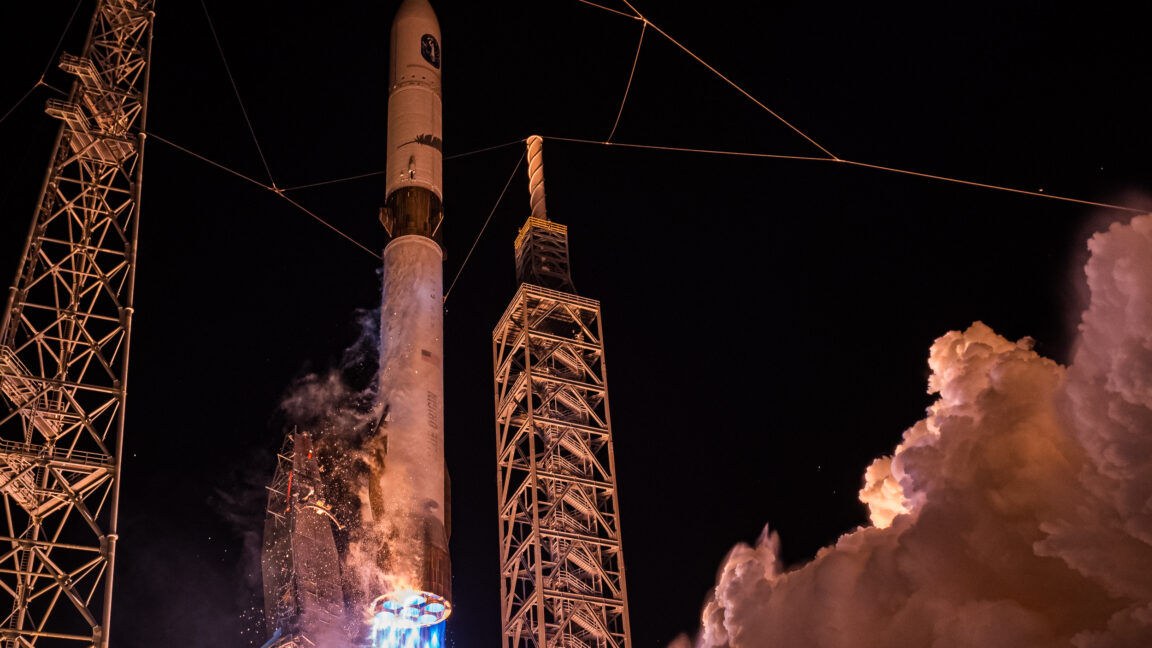Science
Blue Origin’s New Glenn Rocket Launch Crucial for Future Missions

Blue Origin’s upcoming launch of the New Glenn rocket is pivotal for the company’s future ambitions, particularly its plans for lunar exploration and Mars missions. The second flight of this heavy-lifter will deliver two NASA-funded satellites to study Mars’s upper atmosphere, focusing on the planet’s transition from a warmer, wetter environment to its current cold, dry state. A successful launch will not only advance scientific research but also bring Blue Origin closer to obtaining certification from the U.S. Space Force for launching national security satellites.
The stakes are particularly high as Blue Origin aims to recover the first-stage booster of the New Glenn rocket during this mission. This recovery is essential for the company’s plans to launch its first robotic Moon lander, slated for early next year. To achieve this, crews will deploy Blue Origin’s landing platform into the Atlantic Ocean, mirroring the approach taken during the inaugural New Glenn flight in January. Although that first launch successfully reached orbit, the booster fell into the ocean after three engines failed to reignite for landing.
In response, engineers have implemented seven design changes aimed at improving “propellant management and engine bleed control.” Pat Remias, Blue Origin’s Vice President of Space Systems Development, expressed confidence in the upcoming attempt, stating, “We fully intend to recover the New Glenn first stage on this next launch.” The anticipated launch window is set for no earlier than November from the Cape Canaveral Space Force Station in Florida.
Strategic Importance of the New Glenn Launch
The upcoming launch represents a critical moment not just for Blue Origin but also for its founder, billionaire Jeff Bezos, and the broader context of U.S. space ambitions. The booster for this mission has been dubbed “Never Tell Me The Odds,” reflecting the company’s bold commitment to reusing its hardware effectively. This launch is particularly significant as it sets the stage for the third New Glenn flight, planned for January 2024, which will utilize the same booster if the recovery is successful.
The payload for that mission will include Blue Origin’s first lunar lander, known as Blue Moon Mark 1. This uncrewed vehicle is designed to deliver up to 3 metric tons (approximately 6,600 pounds) of cargo to the lunar surface, surpassing the height of the lunar landers used during NASA’s Apollo missions at about 26 feet (or 8 meters). Blue Origin aims to demonstrate its lander’s capabilities in support of NASA’s efforts to return astronauts to the Moon.
The launch strategy is ambitious, with Blue Origin initially planning eight New Glenn flights this year. However, it now anticipates concluding with just two. Laura Maginnis, the company’s Vice President of New Glenn Mission Management, indicated that they are building a fleet of several boosters while also having eight upper stages in storage. This preparation could facilitate a quicker ramp-up in launch frequency next year.
Challenges and Future Prospects
Despite the preparations, challenges remain. Blue Origin has yet to inspect or test a recovered New Glenn booster, and any issues that arise from the recovery could impact future launches. Dave Limp, Blue Origin’s CEO, acknowledged that successful recovery on the second flight will require “a little bit of luck and a lot of excellent execution.”
The implications of a successful launch extend beyond Blue Origin’s commercial goals. With China also advancing its lunar program and targeting a crewed landing by 2030, the urgency for the United States to expedite its lunar ambitions is apparent. Experts suggest that leveraging a modified version of Blue Origin’s Mark 1 lander could accelerate progress for NASA.
The coming weeks will be critical for Blue Origin as it gears up for this significant launch. If successful, it will not only mark a pivotal moment for the New Glenn rocket but also contribute to a broader narrative of renewed U.S. efforts in space exploration and technology.
-

 Lifestyle1 month ago
Lifestyle1 month agoWinnipeg Celebrates Culinary Creativity During Le Burger Week 2025
-

 Health2 months ago
Health2 months agoMontreal’s Groupe Marcelle Leads Canadian Cosmetic Industry Growth
-

 Science2 months ago
Science2 months agoMicrosoft Confirms U.S. Law Overrules Canadian Data Sovereignty
-

 Education2 months ago
Education2 months agoRed River College Launches New Programs to Address Industry Needs
-

 Technology2 months ago
Technology2 months agoDragon Ball: Sparking! Zero Launching on Switch and Switch 2 This November
-

 Science2 months ago
Science2 months agoTech Innovator Amandipp Singh Transforms Hiring for Disabled
-

 Technology2 months ago
Technology2 months agoGoogle Pixel 10 Pro Fold Specs Unveiled Ahead of Launch
-

 Science2 months ago
Science2 months agoChina’s Wukong Spacesuit Sets New Standard for AI in Space
-

 Technology2 months ago
Technology2 months agoWorld of Warcraft Players Buzz Over 19-Quest Bee Challenge
-

 Science2 months ago
Science2 months agoXi Labs Innovates with New AI Operating System Set for 2025 Launch
-

 Business2 months ago
Business2 months agoDawson City Residents Rally Around Buy Canadian Movement
-

 Business2 months ago
Business2 months agoNew Estimates Reveal ChatGPT-5 Energy Use Could Soar
-

 Technology2 months ago
Technology2 months agoInnovative 140W GaN Travel Adapter Combines Power and Convenience
-

 Technology2 months ago
Technology2 months agoFuture Entertainment Launches DDoD with Gameplay Trailer Showcase
-

 Technology2 months ago
Technology2 months agoGlobal Launch of Ragnarok M: Classic Set for September 3, 2025
-

 Education2 months ago
Education2 months agoAlberta Teachers’ Strike: Potential Impacts on Students and Families
-

 Technology2 months ago
Technology2 months agoArsanesia Unveils Smith’s Chronicles with Steam Page and Trailer
-

 Technology2 months ago
Technology2 months agoNew IDR01 Smart Ring Offers Advanced Sports Tracking for $169
-

 Technology2 months ago
Technology2 months agoHumanoid Robots Compete in Hilarious Debut Games in Beijing
-

 Science2 months ago
Science2 months agoNew Precision Approach to Treating Depression Tailors Care to Patients
-

 Health2 months ago
Health2 months agoGiant Boba and Unique Treats Take Center Stage at Ottawa’s Newest Bubble Tea Shop
-

 Technology2 months ago
Technology2 months agoQuoted Tech Launches Back-to-School Discounts on PCs
-

 Business2 months ago
Business2 months agoBNA Brewing to Open New Bowling Alley in Downtown Penticton
-

 Technology2 months ago
Technology2 months agoDiscover the Relaxing Charm of Tiny Bookshop: A Cozy Gaming Escape









